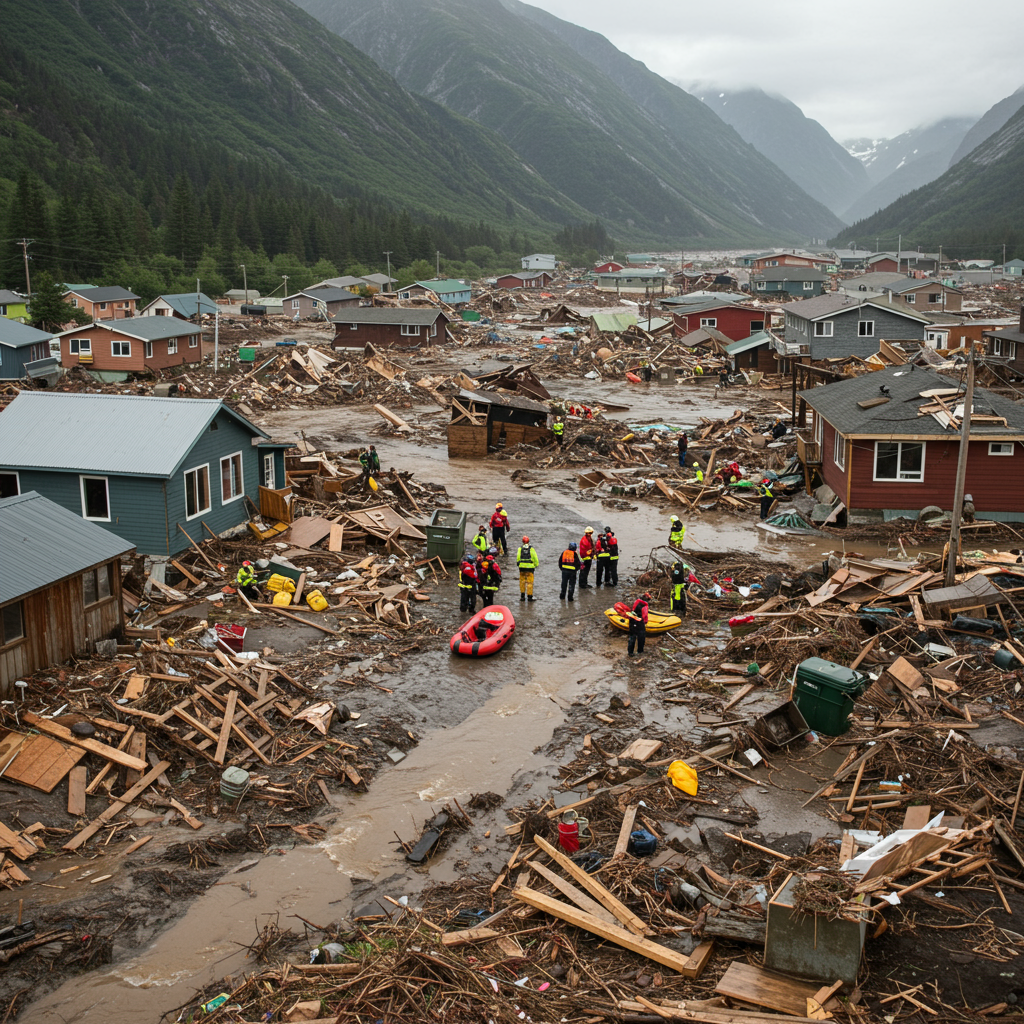Western Alaska is reeling from a catastrophic flooding event, as remnants of Typhoon Halong unleashed hurricane-force winds and unprecedented storm surges on coastal communities. This devastating natural disaster, striking on Sunday, October 12, 2025, has torn entire houses from their foundations, displaced hundreds, and triggered urgent search and rescue missions. The remote nature of the affected villages amplifies the humanitarian crisis, challenging an extensive multi-agency response to locate the unaccounted for and provide aid.
Typhoon Halong’s Devastating Blow to Western Alaska
The Pacific’s powerful Typhoon Halong, now downgraded but still formidable, delivered a brutal impact to Alaska’s western coastline. On that fateful Sunday, the storm’s remnants generated relentless hurricane-force winds and an immense storm surge, inundating numerous coastal villages. Reports quickly emerged of homes being violently pushed off their foundations and swept away by the surging waters, raising immediate fears for residents who may have been inside. This event underscores the severe vulnerability of Alaska’s coastal regions to intensifying storm systems.
Coastal Communities Bear the Brunt
The tiny Alaskan villages of Kipnuk and Kwigillingok bore the immediate and most severe consequences of Typhoon Halong’s fury. Alaska State Troopers confirmed that “strong winds and heavy flooding” caused significant destruction, with at least eight homes dislodged from their foundations across these communities. Beyond these two villages, other Yukon-Kuskokwim communities like Bethel, Napaskiak, and Napakiak also experienced widespread damage, including inundated roads, boardwalks, and crippled power infrastructure. The sheer scale of destruction has left many residents without shelter and basic services.
Urgent Search and Rescue Operations Underway
As the floodwaters raged, an urgent and extensive search and rescue operation was immediately launched. Initial reports indicated up to 20 individuals were potentially unaccounted for in Kipnuk and Kwigillingok, igniting fears that people were trapped within their floating homes. Jeremy Zidek, spokesperson for the state Division of Homeland Security and Emergency Management, highlighted the gravity of the situation, confirming reports of homes drifting away with occupants possibly inside. Rescue aircraft were quickly dispatched to these isolated locations. By Sunday evening local time, at least 18 people had been successfully rescued in Kwigillingok, and 16 in Kipnuk. Despite these heroic efforts, three individuals in Kwigillingok remained unaccounted for, with unconfirmed numbers still missing in Kipnuk. Search teams continued their relentless efforts overnight, battling challenging conditions in a race against time.
Humanitarian Crisis and Infrastructure Collapse
The impact of the Alaska flooding extends far beyond structural damage, plunging hundreds into a dire humanitarian situation. Basic necessities like shelter, clean water, and power became immediate concerns for residents whose lives were abruptly upended. The region’s unique geography, characterized by extreme isolation and limited transportation networks, compounds the difficulty of delivering aid and establishing recovery efforts.
Sheltering the Displaced
In the immediate aftermath of the storm, local schools rapidly transformed into emergency shelters for the displaced. The nonprofit Coastal Villages Region Fund reported that nearly 600 people in Kipnuk sought refuge in a local school. Similarly, approximately 300 individuals in Kwigillingok found shelter in their community school. These figures represent a significant portion of the villages’ populations, highlighting the widespread need for emergency housing and support. Providing comfort and basic supplies to these hundreds of evacuees became a top priority for responders.
Isolated Regions Face Unique Obstacles
Western Alaska’s remote landscape presents formidable challenges for disaster response. Many communities have few conventional roads, relying instead on boardwalks, boats, and snowmobiles for daily travel. This isolation means that critical infrastructure, like the airport runway in Bethel, is essential for outside aid. Crews worked diligently to clear the Bethel runway of debris from high winds, ensuring it remained operational for rescue and supply flights. The damaged power lines and inundated transport routes further exacerbate the difficulties, making it arduous to reach affected areas and distribute necessary resources to the Western Alaska communities.
Coordinated Emergency Response and State Action
The scale of the Alaska flooding necessitated a robust and integrated emergency response involving multiple state and federal agencies. From initial search efforts to long-term recovery planning, a collaborative approach is crucial to navigate the complexities of this disaster. Governor Mike Dunleavy has been actively involved, mobilizing state resources and issuing declarations to expedite relief.
Multi-Agency Efforts for Survival
The ongoing search and rescue operation is a testament to inter-agency cooperation. The Alaska State Troopers are coordinating the efforts, receiving critical assistance from the Alaska Air National Guard, Alaska Army National Guard, and the U.S. Coast Guard. CBS Fairbanks affiliate KXDF-TV reported that over a dozen agencies are actively involved in the disaster response. Furthermore, the Alaska Organized Militia, which includes the Alaska National Guard, Alaska State Defense Force, and Alaska Naval Militia, was activated, with up to 60 members requested to assist with storm response operations. This extensive network of responders is vital for reaching remote areas and saving lives.
Governor Dunleavy’s Immediate Response
Alaska Governor Mike Dunleavy swiftly acknowledged the severity of the crisis, assuring residents that “Help is on the way.” He emphasized that “every effort will be made to help those hit by this storm.” The Governor expanded the state’s disaster declaration to encompass all areas affected by the storm. This move followed an initial disaster declaration issued just days prior for western Alaska in response to an earlier powerful storm, underscoring a concerning pattern of severe weather impacts on the region. The expansion of the declaration unlocks crucial state resources and funding for recovery and aid.
Alaska’s Broader Battle with Extreme Weather
The catastrophic Alaska flooding from Typhoon Halong’s remnants is not an isolated incident but rather a stark reminder of Alaska’s increasing vulnerability to extreme weather events. While western Alaska grappled with storm surge, other parts of the state and nation faced their own concurrent weather emergencies, highlighting a challenging period for emergency services.
A Season of Severe Weather Challenges
Compounding the crisis in western Alaska, the state capital, Juneau, faced an “imminent threat of catastrophic flooding” from a glacial lake outburst flood (GLOF) around the same time. The Mendenhall Glacier began releasing a GLOF from Suicide Basin, prompting evacuation calls for residents along the Mendenhall River. This distinct natural phenomenon, a consequence of retreating glaciers, has become an annual threat for Juneau, causing significant damage in prior years, including sweeping away homes. Governor Dunleavy had already issued a state disaster declaration for Juneau on Sunday due to this separate but equally severe flooding risk.
Simultaneously, a powerful nor’easter battered the East Coast of the United States, bringing heavy surf, high winds, and extensive coastal flooding from the Carolinas to New England. This nationwide pattern of intense weather events stretched emergency resources thin and demonstrated the broad impact of climatic shifts across the country. The convergence of these significant weather occurrences—Typhoon Halong’s remnants in western Alaska, the Juneau GLOF threat, and the East Coast nor’easter—paints a clear picture of a challenging and active weather season.
The Lingering Aftermath and Path Forward
As the immediate danger subsides, the long road to recovery begins for the Western Alaska communities devastated by Typhoon Halong. The task ahead involves not only rebuilding homes and infrastructure but also bolstering resilience against future extreme weather events. The concerted efforts of numerous agencies, coupled with state and federal support, will be vital in helping residents navigate this challenging period. The focus will shift from immediate rescue to assessing damage, providing sustained humanitarian aid, and implementing long-term recovery plans to restore a semblance of normalcy. This disaster serves as a potent reminder of the profound impact of climate change on vulnerable, isolated regions.
Frequently Asked Questions
What caused the recent catastrophic flooding in Western Alaska?
The recent catastrophic flooding in Western Alaska was primarily caused by the remnants of Typhoon Halong. This powerful storm, though downgraded, brought hurricane-force winds and a severe storm surge on Sunday, October 12, 2025. The immense force of the water and wind was strong enough to push entire homes off their foundations and inundate coastal communities, leading to widespread destruction and an urgent need for rescue efforts across the region.
Which Alaskan communities were most affected by Typhoon Halong’s remnants?
The tiny Alaskan villages of Kipnuk and Kwigillingok were among the most severely affected communities, reporting at least eight homes dislodged from their foundations. Other communities in the broader Yukon-Kuskokwim region, including Bethel, Napaskiak, and Napakiak, also experienced significant damage. These areas faced widespread infrastructure failures, including inundated roads, damaged boardwalks, and power outages, further complicating rescue and relief operations due to their remote and isolated locations.
How are rescue and relief efforts coordinated for remote Alaskan villages?
Rescue and relief efforts for remote Alaskan villages are coordinated through a multi-agency approach led by the Alaska State Troopers. They receive critical assistance from numerous entities, including the Alaska Air National Guard, Alaska Army National Guard, and the U.S. Coast Guard. The Alaska Organized Militia also activates members to support operations. This extensive network is crucial for reaching isolated communities, often relying on aircraft for transport, to conduct search and rescue missions, deliver essential supplies, and evacuate displaced residents to safe shelters like local schools.
Conclusion
The recent Alaska flooding resulting from the remnants of Typhoon Halong represents a profound challenge for Western Alaska. The devastation, from homes swept away to critical infrastructure damage, highlights the unique vulnerabilities of these remote communities. While immediate rescue and relief operations demonstrate incredible resolve and inter-agency coordination, the long-term recovery will require sustained effort and resources. This event, occurring amidst other severe weather incidents across Alaska and the U.S., underscores the urgent need for enhanced disaster preparedness and resilience strategies in the face of an evolving climate.
References
- www.cbsnews.com
- apnews.com
- www.ajc.com
- <a href="https://pressofatlanticcity.com/news/ap/newjersey/article5e2ae642-d151-54b3-b3fb-6d0595b76b0c.html”>pressofatlanticcity.com
- www.cbsnews.com



